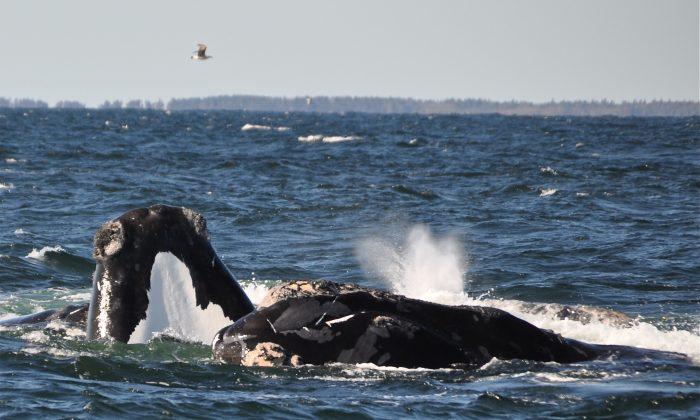Fisheries and Oceans Canada issued a new alert on June 25 after another critically endangered North Atlantic right whale spotting in the Gulf of St. Lawrence off the Atlantic coast.
The closures are part of a plan in response to 12 unexpected deaths of the critically endangered right whales in the Gulf of St. Lawrence last year. Necropsies of six whales found the cause of death to be chronic entanglement or blunt trauma.
The government predominantly uses planes to spot the whales, so that appropriate action can be taken to protect them from human danger caused by fishing and boats. At any given time, the government has as many as five planes in the air, with experts specifically looking for right whales, according to Adam Burns, the director general for Fisheries Resource Management at Fisheries and Oceans Canada (FOC).
Burns said that if a right whale is spotted in any key areas in the Gulf of St. Lawrence, that area will be closed to all fixed-gear fisheries in the water for a 15-day period.
“When the whales are foraging, there are a couple of things [to consider].“ he said. ”Their feeding behaviour makes them more susceptible to entanglement but also, in foraging areas there tends to be aggregation of whales, so there tend to be more present.”
During the closure time, the government flies over the area, trying to see if whales are still there. If there are at least two “clear flights,” then the area is reopened to fishing.
After the previous alert on June 23, Maritime Fishermen’s Union president Carl Allen expressed that the closure would not greatly affect fishermen.
“It’s not of huge consequence considering the location of where it’s at and the timing of it.”
But there is the possibility for greater consequence for fishermen.
“Every time we get an email with notice to harvesters, alerting us to another closure, it’s like those few seconds that it takes to load the map up to see where the closure is, are like the longest few seconds in your life some days.”
The Maritime Fishermen’s Union and the Pecheurs professionnels du Sud de la Gaspesie did propose a shallow water exemption to the government, but is was rejected, the Canadian Press reported.
Burns said the government understands the impact that this year’s conservation effort has had, “in particular on the Acadian Peninsula of New Brunswick and in Gaspe Bay, but also elsewhere where closures have had an impact of harvesters.”
The government is following the protocols that have been designed for 2018. Burns said this autumn the government will be working with the fishing industry, local indigenous communities, and provincial authorities to assess areas of improvement in the conservation effort in 2019, keeping priorities like economics and conservation in mind.

“Our objective is to have a robust regime in place to protect the right whales while at the same time allowing for fisheries to occur,” He said. “So if there are ways we can improve those protocols in future years that’s something we are open to considering.”
“The minister undertook significant consultation in developing these measures,“ Burns said. ”And the consequences of not adequately protecting the whales could be far more serious.”





Friends Read Free